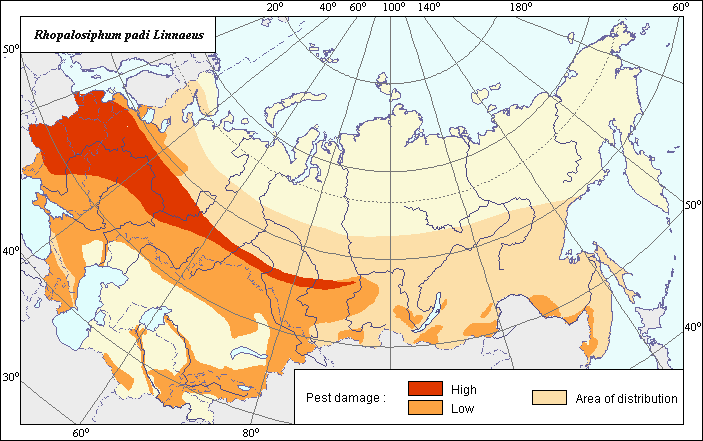Pests
The area and harmfulness zones of Rhopalosiphum padi Linnaeus.
 Object description Download GIS-layers
Object description Download GIS-layers
Authors:
Specialist-biologist - M.N. Berim, GIS-specialist - M.I. Saulich.Date of creation:
2.12.2003.Scale:
1:20 000 000.Accuracy of map:
Map was created based on materials of map of natural scale 1:40 000 000.Projection:
"Alber's Equal Area Conic", 9, 1001, 7, 100, 0, 44, 68, 0, 0.Basic contents:
Vector map. Area of species distribution is shown by polygons. Zones of pest damage are shown by polygons.Accuracy of classifier:
The insect area is divided into zones of strong and low (weak) harm.The zones with strong harmfulness are the regions that are characterized by periodical mass reproductions of the pest according to balls 5, 7, and 9, and the zones of low harmfulness, according to balls 1 and 3.
Method of map production:
Scientists were given maps with boundaries of Oblasts and arable lands. After reviewing historic literature and VIZR expedition data, species distribution was hand drawn on maps. The borders of the zones of harmfulness were drawn according to the following sources: Radchenko (1991), Berim & Radchenko (2002). If data were on the Oblast-level, distribution is on the Oblast level. In some cases, Oblast.s are further refined by boundaries of the Arable Land Map (Koroljeva et al., 2003). Hand drawn maps were scanned, georeferenced and vectorized. The northern border was determined according to published materials (Shaposhnikov, 1964; Ivanovskaya, 1977), by the analysis of the spreading of the first and second hosts according to the atlas of the USSR vegetation and by the temperature preference of this insect. The distribution of wheat, barley, rye, millet, and oats within the territory of the Former Soviet Union has also been considered.Reference citations:
Berim M.N., Radchenko E.E. 2002. Methods of estimation and identification of cereal aphids. Methodical recommendations. Moscow. 3-21 p. (In Russian)Bozhko M.P. 1950. On the fauna of aphids of Kharkov and Sumy Regions. Trudy NII biologii Khar.kovskogo gosudarstvennogo universiteta, 14-15: 184-187. (In Russian)
Ivanovskaya O.I. 1977. Aphids of West Siberia. Part II. Novosibirsk: Nauka. 34-35 pp. (In Russian)
Kann A.A., Ibraimova K.I., Yukhnevich L.A. 1976. The cereal aphid and its distribution in Middle Asia and Kazakhstan. Frunze: Ilim. 45 p. (In Russian)
Koroljeva IE, Vilchevskaya EV, Ruhovich DI. 2003. Digital Arable Land Map. Laboratory of Soil Information of the Dokuchaev Soil Institute, Moscow, Russia [Based on: Yanvareva LF. (ed.), Martynjuk KN., Kisileva NM. 1989. Map of Land Use, Faculty of Geography, Moscow State University, Moscow, Russia.].
Mamontova V.A. 1953. The aphids on agricultural crops of rightbank forest-steppe zone of Ukraine. In: Belanovskii I.I., ed. Trudy instituta zoologii AN USSR. Kiev: Izd. ANUSSR. 62-63 p. (In Russian)
Polyakov I.Ya., ed. 1975. Distribution of the main pests of agricultural crops in the USSR and efficiency of their control, Methodical recommendations. Leningrad: VASKHNIL, VIZR. 66 p. (In Russian)
Radchenko E.E. 1991. The study of resistance of grain cultures to aphids (Methodical recommendations). Saint Petersburg: VIZR. 4-5 pp. (In Russian)
Shaposhnikov G.H. 1964. Suborder Aphidinea - aphids. In: Bei-Bienko G.Ja, ed. Keys to the insects in the European part of the USSR. Opredelitel. nasekomykh Evropeiskoi chasti SSSR. Moscow & Leningrad: Nauka. V.1: 489-616. (In Russian)
Vasil.ev V.P., ed. 1973. The pests of agricultural crops and forest plantations. Kiev: Urozhai. V. 1: 274-275. (In Russian)
Right and copyright:
All rights reserved.Copyright 2003 © M.N. Berim & M.I. Saulich (vector map, description), M.N. Berim (picture).

